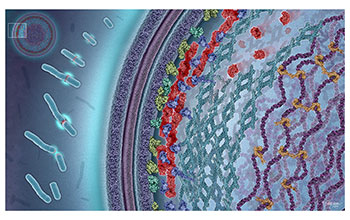Multimedia Gallery
'The FtsZ ring: a multilayered protein network'
"The FtsZ ring: a multilayered protein network," by Jennifer E. Fairman.
When her colleague Jie Xiao approached her to make an illustration for a journal article, Jennifer Fairman didn't know just how challenging the assignment would be. Xiao was studying E. coli bacteria. Her team had revealed the arrangement of proteins, including one called FtsZ, at the site where E. coli bacterium divides.
Though she was working for a scientific audience, Fairman says she hopes the layperson can appreciate the complexity of the microscopic world in the image. Harold Erickson, a cell biologist at Duke University who has studied FtsZ but wasn't involved in the research, called the model "quite an achievement."
More about this image
This illustration won people's choice in the Illustration category of the 2016 Visualization Challenge, now called the Vizzies, a long-running annual competition co-sponsored by the National Science Foundation (NSF) and Popular Science magazine. [The competition was formerly named the International Science & Engineering Visualization Challenge (SciVis) and was previously co-sponsored with AAAS' journal Science.] The competition aims to recognize some of the most beautiful visualizations from the worlds of science and engineering, and awards prizes in five categories: photography, video, illustration, posters & graphics and interactives.
To learn more about the competition and view all the winning entries, past and present, see the NSF Special Report The VIZZIES: Visualization Challenge. (Date image taken: 2016; date originally posted to NSF Multimedia Gallery: Jan. 2, 2017)
Credit: Jennifer E. Fairman
Images and other media in the National Science Foundation Multimedia Gallery are available for use in print and electronic material by NSF employees, members of the media, university staff, teachers and the general public. All media in the gallery are intended for personal, educational and nonprofit/non-commercial use only.
Images credited to the National Science Foundation, a federal agency, are in the public domain. The images were created by employees of the United States Government as part of their official duties or prepared by contractors as "works for hire" for NSF. You may freely use NSF-credited images and, at your discretion, credit NSF with a "Courtesy: National Science Foundation" notation.
Additional information about general usage can be found in Conditions.
Also Available:
Download the high-resolution JPG version of the image. (5.8 MB)
Use your mouse to right-click (Mac users may need to Ctrl-click) the link above and choose the option that will save the file or target to your computer.

